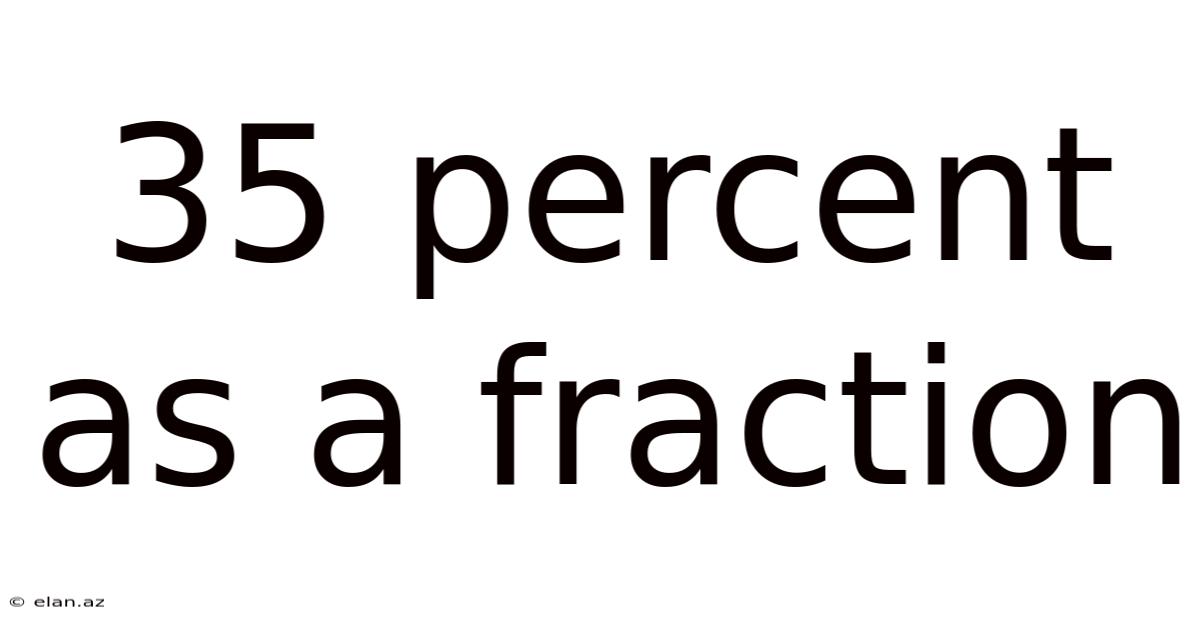35 Percent As A Fraction
elan
Sep 15, 2025 · 5 min read

Table of Contents
Understanding 35 Percent as a Fraction: A Comprehensive Guide
35 percent, often written as 35%, represents a part of a whole. Understanding how to express this percentage as a fraction is a fundamental skill in mathematics, crucial for various applications from everyday calculations to advanced statistical analysis. This comprehensive guide will delve into the process of converting 35% to a fraction, exploring different methods, simplifying the fraction, and showcasing its practical applications. We'll also tackle common misconceptions and answer frequently asked questions to solidify your understanding.
From Percentage to Fraction: The Conversion Process
The term "percent" literally means "out of one hundred." Therefore, 35% directly translates to 35 out of 100. This understanding forms the basis for our conversion:
Step 1: Write the Percentage as a Fraction with a Denominator of 100
35% can be written as the fraction 35/100. This is the most straightforward step; the percentage number becomes the numerator, and 100 becomes the denominator.
Step 2: Simplify the Fraction
The fraction 35/100 is not in its simplest form. To simplify, we need to find the greatest common divisor (GCD) of both the numerator (35) and the denominator (100). The GCD is the largest number that divides both 35 and 100 without leaving a remainder.
In this case, the GCD of 35 and 100 is 5. We divide both the numerator and the denominator by 5:
35 ÷ 5 = 7 100 ÷ 5 = 20
Therefore, the simplified fraction is 7/20.
Alternative Methods for Conversion
While the direct conversion method is the most efficient, understanding alternative methods can enhance your comprehension of percentages and fractions.
Method 1: Using Decimal as an Intermediate Step
First, convert the percentage to a decimal by dividing by 100:
35% ÷ 100 = 0.35
Next, write the decimal as a fraction. 0.35 can be written as 35/100. This fraction can then be simplified as shown above to 7/20.
Method 2: Understanding the Concept of Proportion
Percentages represent a proportion. 35% means 35 parts out of 100 parts. This can be expressed as a proportion:
35/100 = x/y
Where 'x' represents the number of parts and 'y' represents the total number of parts. If you know the total number of parts (y), you can solve for 'x' to find the corresponding number of parts represented by 35%.
For example, if you have 100 apples, 35% of them (35 apples) would be represented by the fraction 35/100, simplifying to 7/20. If you have 200 apples, 35% would be 70 apples (35/100 = 70/200), which also simplifies to 7/20. This demonstrates that the fraction remains consistent despite changes in the total quantity.
Practical Applications of 7/20
The fraction 7/20, representing 35%, has numerous practical applications across various fields:
-
Retail Discounts: A 35% discount on a $100 item means a reduction of $35 ($100 x 7/20 = $35).
-
Statistical Analysis: In data analysis, 35% of a sample size can be easily calculated using the fraction 7/20.
-
Recipe Scaling: If a recipe calls for 100 grams of flour and you want to reduce the recipe by 35%, you would use 7/20 of the flour (100 grams x 7/20 = 35 grams).
-
Financial Calculations: Calculating interest, taxes, or profit margins often involves using percentages, which can be simplified to fractions for easier computation.
The Importance of Fraction Simplification
Simplifying fractions like 35/100 to 7/20 is crucial for several reasons:
-
Clarity: Simplified fractions are easier to understand and interpret than complex fractions.
-
Efficiency: Simplified fractions are easier to work with in calculations.
-
Accuracy: Working with simplified fractions reduces the risk of calculation errors.
Addressing Common Misconceptions
A common misconception is that percentages and fractions are entirely separate concepts. This is incorrect; they are interconnected and represent different ways of expressing the same proportional relationship. Understanding this connection is crucial for mastering mathematical concepts.
Frequently Asked Questions (FAQ)
Q1: Can 7/20 be further simplified?
A1: No. 7 and 20 share no common divisors other than 1, meaning 7/20 is already in its simplest form.
Q2: How do I convert a fraction back to a percentage?
A2: To convert a fraction back to a percentage, divide the numerator by the denominator and multiply by 100. For example, 7/20 = 0.35 x 100 = 35%.
Q3: What if the percentage isn't a whole number, like 35.5%?
A3: You'll follow the same process. 35.5% becomes 35.5/100. You can simplify this by multiplying both the numerator and denominator by 10 to remove the decimal, resulting in 355/1000. This can then be simplified further by finding the GCD.
Q4: Are there any online tools to help with fraction simplification?
A4: Yes, many online calculators and websites are available to assist in simplifying fractions. However, understanding the manual process is essential for building a solid mathematical foundation.
Conclusion
Converting 35% to the fraction 7/20 is a straightforward yet fundamental process in mathematics. This guide has illustrated multiple methods for conversion, highlighted the importance of simplification, and provided practical applications to demonstrate the real-world relevance of this seemingly simple concept. Mastering this skill will significantly improve your ability to handle various mathematical problems and enhance your overall understanding of proportional relationships. Remember to practice these methods regularly to solidify your understanding and build confidence in tackling more complex percentage and fraction problems.
Latest Posts
Latest Posts
-
2 25 As A Percent
Sep 15, 2025
-
Resistivity Practical A Level Physics
Sep 15, 2025
-
Germinate Seeds With Paper Towel
Sep 15, 2025
-
Fractions Improper To Mixed Worksheets
Sep 15, 2025
-
Hcf Of 8 And 14
Sep 15, 2025
Related Post
Thank you for visiting our website which covers about 35 Percent As A Fraction . We hope the information provided has been useful to you. Feel free to contact us if you have any questions or need further assistance. See you next time and don't miss to bookmark.